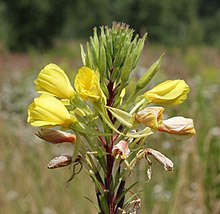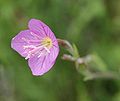Oenothera
Oenothera is a
Description
The species vary in size from small
Ecology

Oenothera flowers are pollinated by insects, such as moths and bees. Like many other members of the Onagraceae, however, the pollen grains are loosely held together by viscin threads, so only insects that are morphologically specialized to gather this pollen can effectively pollinate the flowers. Bees with typical scopa cannot hold it. Also, the flowers open at a time when most bee species are inactive, so the bees which visit Oenothera are generally vespertine temporal specialists: bees that forage in the evening. The seeds ripen from late summer to fall.
Oenothera are used as food plants by the larvae of some Lepidoptera species, including the large white-lined sphinx (Hyles lineata).[7] The flower moths Schinia felicitata and S. florida both feed exclusively on the genus, and the former is limited to O. deltoides.
In the wild, some species of evening primrose act as primary colonizers, quickly appearing in recently cleared areas. They germinate in disturbed soils, and can be found in habitat types such as dunes, roadsides, railway embankments, and waste areas. They are often casual and are eventually out competed by other species.
Based on observations of evening primroses (O. drummondii), a study discovered that within minutes of sensing the sound waves of nearby bee wings through flower petals, the concentration of the sugar in the plant's nectar was increased by an average of 20 percent. Experiments were also conducted on flowers with the petals removed. No change in nectar production was noted, indicating that it is indeed the flowers that have the job of the ears.[8]
Origin
The genus Oenothera may have originated in
Genetics

The pattern of repeated colonizations resulted in a unique genetic conformation in the Euoenothera whereby the
The appearance of sudden changes in
Taxonomy
Evening primroses were originally assigned to the genus Onagra, which gave the family Onagraceae its name. Onagra '[food of] onager' was first used in botany in 1587, and in English in Philip Miller's 1754 Gardeners Dictionary: Abridged. The modern name Oenothera was published by Carolus Linnaeus in his Systema Naturae. Its etymology is uncertain, but it is believed to be derived from the Greek words οίνος θήρα (oinos thera) 'wine seeker'.[19]
The genus is divided into 18
Dietary uses and side effects
Certain Oenothera plants have edible parts. The roots of O. biennis are reportedly edible in young plants.[20]
The common evening primrose, O. biennis, is commonly sold as a
There is no high-quality scientific evidence that O. biennis or evening primrose oil has any effect on human diseases or promotion of health,[21][22] and specifically no evidence that it is effective to treat atopic dermatitis or cancer.[21][23] Research indicates that orally-administered evening primrose oil does not relieve symptoms of premenstrual syndrome,[24][25] and does not have an effect on shortening the length of pregnancy or labor.[26][27][28][29]
Consuming evening primrose oil may cause headache or stomach upset, may increase the risk of complications during pregnancy, and may increase the risk of bleeding in people given prescription drugs as anticoagulants, such as warfarin.[30]
Cultivation
A number of perennial members of the genus are commonly cultivated and used in landscaping in the southwestern United States. Popular species include tufted evening primrose (Oenothera caespitosa), Mexican evening primrose (Oenothera berlanderii), and Saltillo evening primrose (Oenothera stubbei).[31]
Annual evening primroses are also popular ornamental plants in gardens. Many are fairly drought-resistant.
The first plants to arrive in Europe reached Padua from Virginia in 1614 and were described by the English botanist John Goodyer in 1621. Some species are now also naturalized in parts of Europe and Asia, and can be grown as far north as 65°N in Finland. The UK National Council for the Conservation of Plants and Gardens, based at Wisley, maintains an Oenothera collection as part of its National Collections scheme.
Gallery
-
Oenothera caespitosa var. marginata
-
Oenothera stricta ssp. stricta
-
Oenothera sp. opening
-
Closed flower.
References
- ^ a b "Genus: Oenothera L". Germplasm Resources Information Network. United States Department of Agriculture. 2004-03-22. Archived from the original on 2023-01-09. Retrieved 2023-01-09.
- ^ "GRIN Species Records of Oenothera". Taxonomy for Plants. USDA, ARS, National Genetic Resources Program. Retrieved July 11, 2010.
- PMID 22805077.
- ^ S2CID 55661900.
- ^ Gumbo Lily (Oenothera caespitosa). Native Wildflowers of the North Dakota Grasslands. USGS Northern Prairie Wildlife Research Center.
- ISBN 978-0-395-91172-3.
- ^ "White-lined Sphinx Hyles lineata (Fabricius, 1775)". Butterflies and Moths of North America. Retrieved 2017-11-14.
- ^
Lay summary:
Nield, David (January 19, 2019). "Plants May Not Have Ears, But They Can 'Hear' Way Better Than We Thought". Science Alert.
Veits, Marine; Khait, Itzhak; Obolski, Uri; Zinger, Eyal; Boonman, Arjan; Goldshtein, Aya; Saban, Kfir; Seltzer, Rya; Ben‐Dor, Udi; Estlein, Paz; Kabat, Areej; Peretz, Dor; Ratzersdorfer, Ittai; Krylov, Slava; Chamovitz, Daniel; Sapir, Yuval; Yovel, Yossi; Hadany, Lilach (2019). "Flowers respond to pollinator sound within minutes by increasing nectar sugar concentration". (CNRS).
Veits is cited by many reviews:
Kumar, A.; Memo, M.; Mastinu, A. (2020). "Plant behaviour: an evolutionary response to the environment?". S2CID 219902795. Virant-Doberlet, Meta; Kuhelj, Anka; Polajnar, Jernej; Šturm, Rok (2019). "Predator-Prey Interactions and Eavesdropping in Vibrational Communication Networks".S2CID 173992538. Khait, I.; Obolski, U.; Yovel, Y.; Hadany, L. (2019). "Sound perception in plants".S2CID 106407725. Biorxiv: Veits, Marine; Khait, Itzhak; Obolski, Uri; Zinger, Eyal; Boonman, Arjan; Goldshtein, Aya; Saban, Kfir; Ben-Dor, Udi; Estlein, Paz; Kabat, Areej; Peretz, Dor; Ratzersdorfer, Ittai; Krylov, Slava; Chamovitz, Daniel; Sapir, Yuval; Yovel, Yossi; Hadany, Lilach (2018). "Flowers respond to pollinator sound within minutes by increasing nectar sugar concentration".S2CID 92674047.
- ^ JSTOR 2418422.
- ^ ISBN 978-0-912861-50-0.
- ISBN 978-0-12-176450-0.
- .
- PMID 18791241.
- ISBN 978-0-12-176450-0.
- ISBN 978-3-540-53114-2.
- ^ de Vries, Hugo. Die Mutationstheorie. Versuche und Beobachtungen über die Entstehung von Arten im Pflanzenreich (in German), Leipzig, Veit & Comp., 1901-03.
- ISBN 978-0-674-02713-8.
- PMID 24958925.
- ISBN 978-0-521-86645-3.
- ^ Oenothera biennis. Ohio Perennial and Biennial Weed Guide. The Ohio State University Extension.
- ^ a b c d "Evening primrose oil". National Center for Complementary and Integrative Health, US National Institutes of Health. 1 September 2016. Retrieved 24 June 2020.
- PMID 23633319. CD004416.
- ^ "Gamma Linolenic Acid". American Cancer Society. 13 May 2010. Retrieved 13 August 2013.
- ^ "Evening primrose oil". National Center for Complementary and Integrative Health. 2015-02-14.
- PMID 12489244.
- PMID 10380441.
- PMID 12776961.
- PMID 10949749.
- PMID 10380450.
- ^ "Evening primrose". Drugs.com. 14 October 2019. Retrieved 24 June 2020.
- ISBN 1-55561-190-7
External links
- Onagraceae - The Evening Primrose Family. Smithsonian National Museum of Natural History.
- Plants For A Future
- Szewczyk, Karolina; Lewandowska, Urszula; Owczarek, Katarzyna (2014). "Influence of Polyphenol Extract from Evening Primrose (Oenothera Paradoxa) Seeds on Proliferation of Caco-2 Cells and on Expression, Synthesis and Activity of Matrix Metalloproteinases and Their Inhibitors". Polish Journal of Food and Nutrition Sciences. 64 (3): 181–191. .










